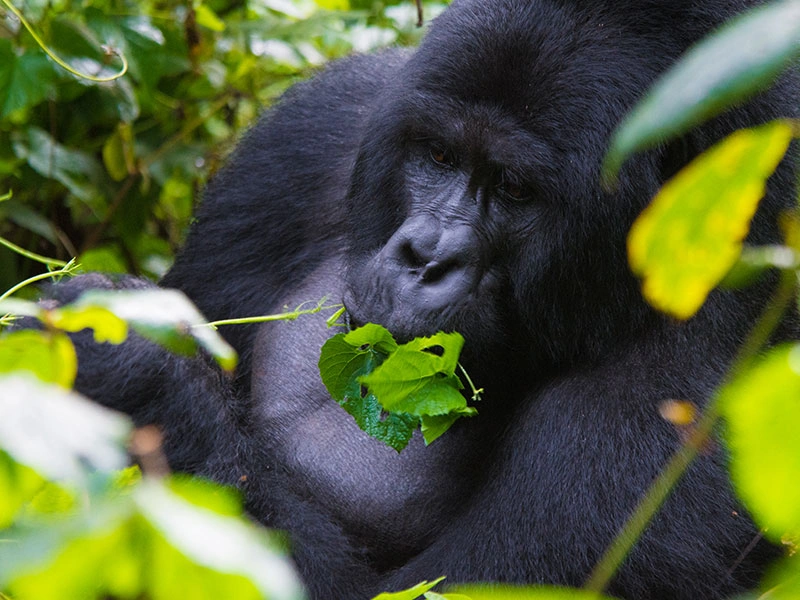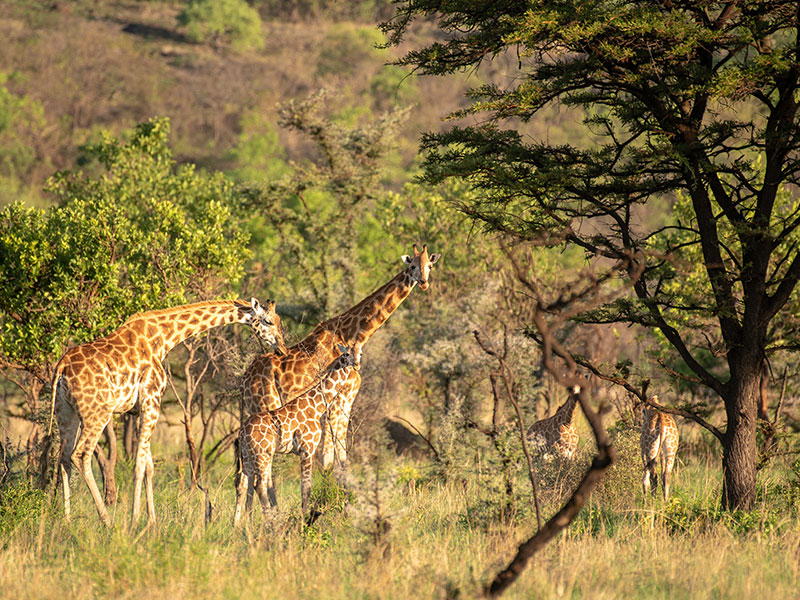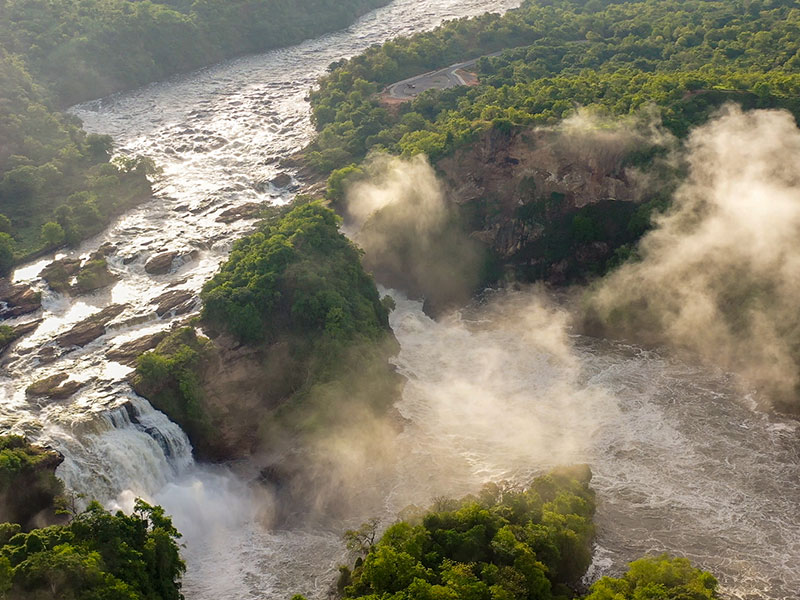
Bwindi Impenetrable National Park is a UNESCO World Heritage Site located in southwestern Uganda, bordering the Democratic Republic of the Congo. It covers approximately 331 square kilometers of both montane and lowland forest, making it one of Africa’s most biologically diverse rainforests. This park is globally recognized for its rich biodiversity and, most notably, for its population of mountain gorillas, an endangered species. Established as a national park in 1991, Bwindi has since become a critical hub for eco-tourism, particularly for gorilla trekking, an activity that draws thousands of visitors from across the globe.
The Ecological Treasure
Bwindi’s forest is believed to be over 25,000 years old, harboring a variety of flora and fauna species that thrive in its dense jungle. The park’s name itself, “Bwindi,” comes from the local language meaning “impenetrable,” a fitting description for the thick undergrowth, vines, and dense canopy that blanket the region. The altitude in Bwindi ranges between 1,160 and 2,600 meters above sea level, creating microclimates that support diverse ecosystems. The park is home to over 400 species of plants, 120 species of mammals, 350 species of birds, and numerous species of butterflies, reptiles, and amphibians. However, its most famous inhabitants are the estimated 459 mountain gorillas (as of 2019), which make up about half of the world’s remaining population. The other half resides in the Virunga Mountains, spanning Uganda, Rwanda, and the Democratic Republic of Congo.
The Emergence of Gorilla Trekking
Mountain gorillas are among the world’s most endangered species, and their existence has been threatened by poaching, habitat destruction, and human-wildlife conflict. The forests of Bwindi provide a safe sanctuary for these gentle giants, thanks to conservation efforts initiated by the Ugandan government and international wildlife organizations. Gorilla trekking in Bwindi began in earnest in the early 1990s, shortly after the park was gazetted. At this time, tourism in the region was still nascent, but the government and conservationists recognized the potential to use tourism as a tool to protect the endangered mountain gorillas. Gorilla trekking was established as a controlled, low-impact activity, with a limited number of permits issued each day to minimize human disturbance to the gorillas’ natural habitat.
The Process of Gorilla Trekking
Gorilla trekking involves an adventurous hike through the dense forest, led by experienced guides and trackers. Each trek takes visitors deep into the jungle in search of one of the park’s habituated gorilla groups. The term “habituated” refers to gorilla families that have undergone a careful process of being acclimatized to human presence, allowing visitors to observe them in their natural surroundings without causing undue stress.
A typical gorilla trekking experience starts early in the morning, with visitors gathering at the park’s headquarters for a briefing by Uganda Wildlife Authority (UWA) rangers. Trekkers are divided into small groups, usually no more than eight individuals, and assigned a gorilla family to track. The treks can range from a few hours to a full day, depending on the location of the gorilla group and the terrain. Once the gorillas are found, visitors are allowed to spend one hour observing them. This moment is the culmination of the trek and offers a rare, intimate glimpse into the life of one of the world’s most extraordinary primates. The gorillas are often seen feeding, grooming each other, playing, or simply lounging in the forest. Observing their social behavior up close is an awe-inspiring experience that leaves a lasting impression on those fortunate enough to partake in the activity.
Conservation and Community Involvement
Gorilla trekking is not only a thrilling wildlife experience but also a crucial component of conservation efforts in Bwindi. The revenue generated from trekking permits, which can cost up to $700 per person, is used to fund conservation projects, including anti-poaching patrols, gorilla health monitoring, and habitat protection. Additionally, a portion of the income is channeled back into the local communities, providing vital support for schools, healthcare, and infrastructure. One of the most important aspects of the conservation strategy in Bwindi is the involvement of the local communities. The Batwa people, who are indigenous to the region, have a long history of living in harmony with the forest. However, they were displaced when Bwindi was declared a national park in 1991, a move that was necessary to protect the gorillas but had significant social consequences for the Batwa. To address this, community-based tourism initiatives have been developed to benefit the Batwa and other local groups. These initiatives include cultural tours, handicraft sales, and employment opportunities related to gorilla trekking and park management. By involving local people in tourism and conservation, the Ugandan government and wildlife organizations aim to foster a sense of ownership and responsibility for the park’s long-term survival.
Gorilla Trekking in Bwindi: 2000 to Present
By the year 2000, gorilla trekking had already gained international recognition as one of the most unique wildlife experiences on the planet. Over the next two decades, Bwindi Impenetrable National Park would see a steady increase in visitor numbers, helping to boost Uganda’s profile as a premier eco-tourism destination. However, this growth also presented challenges, particularly with regards to managing human-wildlife interactions and ensuring that the trekking experience remained sustainable.
Growth of Tourism and Conservation Successes
Throughout the early 2000s, Bwindi benefited from global efforts to conserve mountain gorillas. High-profile campaigns by organizations such as the World Wide Fund for Nature (WWF), the International Gorilla Conservation Programme (IGCP), and the Dian Fossey Gorilla Fund brought attention to the plight of mountain gorillas and helped to secure funding for conservation projects. One of the major achievements during this period was the increase in the number of habituated gorilla families available for trekking. In 1993, only one gorilla family, known as the Mubare group, was habituated for tourism. By the year 2000, several more groups had been habituated, allowing more visitors to participate in trekking without increasing pressure on individual families. Today, there are over 20 habituated groups in Bwindi, spread across different sectors of the park. Conservation efforts have also been successful in stabilizing and even increasing the mountain gorilla population. In the late 1980s, the total population of mountain gorillas was estimated to be around 620 individuals. By 2018, this number had risen to over 1,000, with approximately half of these gorillas residing in Bwindi. This remarkable recovery is a testament to the effectiveness of conservation programs that combine tourism, community involvement, and scientific research.
The Role of Research and Gorilla Health Monitoring
Research has played a pivotal role in the success of gorilla trekking in Bwindi. The Uganda Wildlife Authority, in collaboration with international researchers, has implemented rigorous monitoring programs to track the health and behavior of the park’s gorilla population. Veterinarians from organizations like Gorilla Doctors conduct regular health checks on habituated gorillas, ensuring that diseases, injuries, and other health issues are promptly addressed. The proximity of humans to gorillas during trekking poses a potential risk of disease transmission, as gorillas are susceptible to many human illnesses, including respiratory infections. To mitigate this risk, strict rules are in place for trekkers, including maintaining a minimum distance of seven meters from the gorillas, limiting the number of visitors, and prohibiting individuals who are ill from participating in the trek. In addition to health monitoring, research efforts in Bwindi have focused on understanding the gorillas’ social structure, habitat use, and feeding behavior. This information is crucial for ensuring that conservation strategies are based on sound science and that the needs of the gorillas are prioritized in park management decisions.
Challenges and the Future of Gorilla Trekking in Bwindi
Despite the successes of gorilla conservation in Bwindi, several challenges remain. The ongoing threat of habitat destruction, driven by population growth and agricultural expansion in surrounding areas, continues to pressure the park’s boundaries. Additionally, climate change poses a potential risk to Bwindi’s delicate ecosystems, altering weather patterns and potentially affecting the availability of food resources for the gorillas.
Human-wildlife conflict is another issue, particularly as local communities continue to encroach on gorilla habitats in search of farmland and firewood. Although community-based conservation programs have helped to alleviate some of these tensions, finding a balance between human needs and wildlife protection remains a complex challenge. The future of gorilla trekking in Bwindi will depend on continued efforts to ensure that tourism remains sustainable. This includes maintaining strict regulations on the number of trekking permits issued, minimizing the environmental impact of tourism infrastructure, and ensuring that local communities continue to benefit from the presence of the park.
Bwindi Impenetrable National Park is a unique and invaluable sanctuary for mountain gorillas, offering visitors the rare opportunity to observe these magnificent creatures in their natural habitat. Gorilla trekking has become the park’s signature activity, attracting wildlife enthusiasts and conservationists alike. Over the past few decades, gorilla trekking has played a crucial role in both raising awareness about the plight of mountain gorillas and generating the financial resources needed to protect them.
As we look to the future, the continued success of gorilla trekking in Bwindi will depend on balancing the needs of conservation with the pressures of tourism. By fostering strong partnerships between conservationists, researchers, and local communities, Bwindi Impenetrable National Park will continue to be a beacon of hope for the survival of mountain gorillas and a model for sustainable tourism in Africa.











